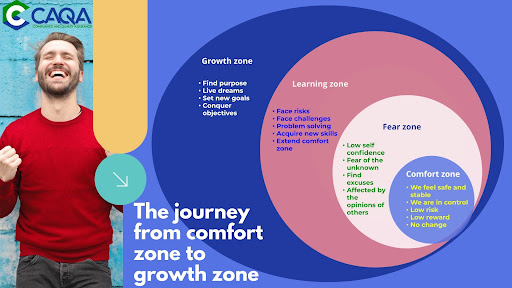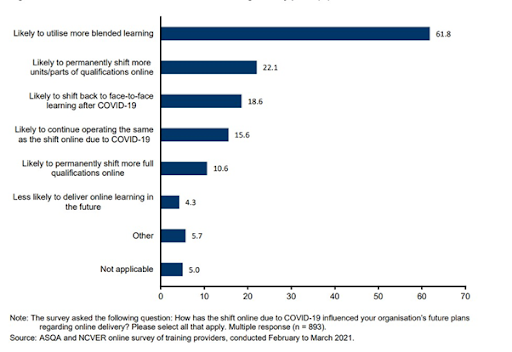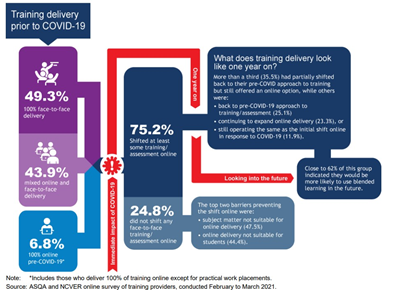Going out of the comfort zone is not easy. It is difficult, challenging and it can be scary. But what if you knew that there was no way to grow without leaving the comfort zone?

The journey from comfort zone to the growth zone can be a tough one. There are many uncertainties and insecurities associated with it. But, if you want to grow as a person, it is important to step out of your comfort zone.
There are various ways in which we can take baby steps and make the transition from our comfort zone to the growth zone easier.
Generally speaking, humans are creatures of what we do as routine practices. They are creatures of habits. However, while we may sit about and talk about doing exciting things and wanting to live life on the edge, what we truly desire is security, safety, protection and stability. There has been no change in wanting and keeping these attributes. The change frightens us and we prefer to remain in our familiar surroundings.
The comfort zone
Our comfort zone is the place where we feel most in command of our lives. We are familiar with how things function and have established routines. This isn’t necessarily a bad thing. Your good habits may include brushing your teeth after every meal, not leaving clothes on the floor, and returning milk to the refrigerator once you’ve finished with it. But there’s more to being a successful person than just having good habits.
The first step to move out of your comfort zone is being accountable for your actions. You have to be ready to accept the truth about yourself, not what you want it to be. This will help you know what needs improvement and where you need development.
The second step is taking action, even if it is small. But with small steps, we can reach the growth zone and make a change in our lives for the better.
Having a sense of security in our familiar surroundings
The comfort zone is a place where we can find stability and a sense of security. It serves as our compass in life. To be honest, who wants to live in a world where everything changes on a daily basis and we never know what will happen next? Even if some things will always be beyond our control, our comfort zone provides a sense of assurance and protection.
Our comfort zone entails a modest level of danger. That’s one of the reasons we like it. However, it comes with a poor monetary payoff. Continually remaining in our comfort zones does not allow us to grow or learn anything new about ourselves. In order to accomplish this, we must try something different. We must make a shift in our thinking.
Change is necessary for us to progress. Change, on the other hand, might be difficult. Our comfort zone is challenged, and this is uncomfortable for all parties involved. Any change, regardless of how significant, such as contemplating a new job or career direction, should be welcomed. Alternatively, it could be something minor, such as opting to try a different restaurant for lunch. When you try something new, there is a risk involved.
The fear zone
Fear of the unknown is what makes people uneasy with change. If you don’t like the new eatery, what do you do? Or is it that you’re not very competent at your new job? Naturally, the hazards in these two circumstances are not the same; but, the feelings or concerns about not doing either are the same in both cases. Speaking in front of a group of people is one of the most prevalent phobias that most individuals face. It is this dread, whether it is fear of the unknown or fear of failure, that causes so much discomfort for many of us.
Consider the experience of returning to school. You’re in the middle of a lesson when a thought occurs to you. It’s an excellent question. You’re waiting for the right moment to ask it. As time passes, however, you begin to question whether this is such a good question after all. You give it a shot in your thoughts and see how it goes. After that, you arrive to the conclusion that the question is dumb. And you certainly don’t want to appear foolish, so you’re not going to ask that question right now, are you?
The same is true for any type of change. For the simple reason that it is unpleasant, we want to avoid it. Then we come up with a list of reasons why it may not be such a good idea after all. Perhaps the new restaurant’s menu will not be to your liking. The illumination is excessively low in this room. It’s possible that it’ll be too pricey. After a few moments of contemplation, you’re back at your favourite eating establishment.
We’ve mastered the art of talking ourselves out of making changes.
When it comes to stepping outside of our comfort zone, we’re experts at convincing ourselves that it’s not a good idea.
This can also happen when we are attempting to make adjustments in our way of life. In any situation, whether it’s beginning a new diet, going to bed early, or quitting smoking, we hunt for reasons not to do something. It’s not going to taste good. You’re only going to watch one more episode of your favourite show on Netflix. Every one of your friends is a smoker. The list could go on and on. And while many of these justifications are reasonable, they aren’t at the heart of the problem of why people are resistant to change.
Consider the following scenario: you wish to get up a half hour earlier each day to workout. The alarm goes off on the first morning of the week. You’re exhausted, and it’s pitch black outside. You convince yourself that you only need a few more minutes in bed before getting out of bed. In no time at all, you’ve used the snooze button twice more, and you’re forced to report to work. You assure yourself that you’ll start the next day.
Getting Out of Your Comfort Zone
All of this is very normal. There are moments when we’ve all been there a number of times. However, we must recognise that stepping outside of our comfort zone is beneficial to our health. It adds to the excitement of everyday living. It’s beneficial. Doing the same thing over and over again can become tedious and stale, both in terms of our physical and mental health. The ability to accept and embrace change allows people to continue to grow and retain their youthful vigour.
This does not imply that you must make significant adjustments in every element of your life. That would also be ineffective because we require our comfort zone to act as an anchor for our efforts.
Learning zone
In order to grow, one needs to be in the learning zone. One can’t just stay in their comfort zone all the time. There is no growth there. In the learning zone, you face challenges, risks, barriers and difficulties that require you to learn new skills and acquire new abilities.
The first step of entering the learning zone is to set some personal goals. These goals should be realistic and achievable. The next step would be to start your learning process by doing some research on how to go about achieving those goals and finding out what you need for this process. Finally, find someone who would like to support you in this process and make sure that they know what you are trying to achieve.
Growth zone
Growth is one of the most important aspects of life. It is important for your personal growth, your professional growth, and your spiritual growth. This is the space where you grow and become a better version of yourself. Where you get to be your best self. Where you allow yourself to dream and then take steps to make them a reality. The growth zone has new challenges but it also has new opportunities. There are uncertainties and insecurities of the unknown territory but there is more room for creativity and experimentation. The more challenges you face, the more you grow!
Conclusion
The first step to take to make the journey from the comfort zone to the growth zone, is to identify what you want. It may seem like a cliché but it’s important to know what you want – do not settle for less. Once you are clear about what you want, then figure out how to get there. This will help build your confidence.
Do not be afraid of rejections or failures, they are natural parts of life and they will happen more often than not. So don’t let them stop you from trying again and again because failure is only a temporary state of being – so keep trying until success comes knocking on your door!
In partnership with Edu Learning and CAQA Skills, CAQA provides a variety of professional and personal development opportunities. We may also tailor the training to meet your specific requirements and skill level as well. For additional details, please contact us at info@caqa.com.au.


















